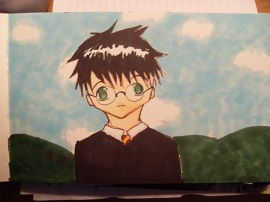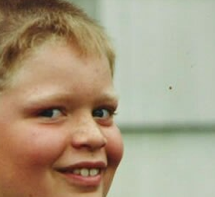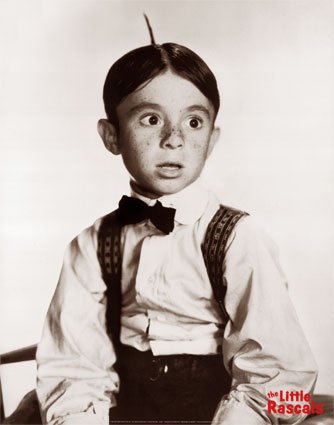I got my hair cut this weekend. Yes, all of the hairs on my head, har har.
My hairdresser, Roger, and I enjoy talking to each other during the whole hair-cutting and -styling process, and this time, one of the things we talked about is cowlicks. I asked him how many of his clients are men (he said about 50%, which surprised me), and does it take less time to cut their hair. He said sometimes it takes longer because their hair is shorter so you have to pay more attention to details and be careful to avoid making visible cut lines. He said it can also take longer if they have a cowlick.
That word is so odd, I of course had to ask him more about it.

Art Clokey, the maker of Gumby, might be the king of the cowlick.
(Photo from Art Baxter's blog)

This drawing comes the closest to how I envisioned Harry Potter before any of the movies came out. Here, it seems he's got about six cowlicks. In later books, he's usually smoothing down the hair at the back of his head, which suggests maybe only one cowlick.
(Drawing from Panda vs. Robot)

This boy's cowlick, visible in his first grade photo, stuck up in every school photo until his hair was allowed to get very long. You can see the progression of hair length at his blog, unappealingly titled Poop and Boogies.

This boy has two cowlicks at the crown of his head. One site reckons that about 10% of the population has double cowlicks.
(Photo from The Outsiders)

This boy has a very obvious cowlick above his forehead. It's kind of like a whorl of hair.
(Photo from Crunchyroll)

This girl has two cowlicks in her bangs. You can tell by the way some of the hair is sort of veering sideways while another strand is sort of puffing out away from her head.
(Photo of Swistle from her eponymous blog, Swistle)

This woman has a cowlick at her nape.
(Photo from Hair Boutique.com)

Too much product on a cowlick and you could wind up looking like Alfalfa.
(Photo from flyte)

This cow has a giant cowlick smack in the middle of its forehead. And doesn't look especially thrilled about it, either.
(Photo from Matter Network)
By the way, if you're interested, this blog has a great series of photos documenting the difficult but in the end incredible process of a calf being born (and getting licked by its mother).
Sources
Encarta, cowlick
Karen Marie Shelton, Hair Boutique.com, Problem Hair: Cowlicks
Hair Cutting Site, Cowlicks, Why Does Cowlick Hair Stand Up?
Jason P. Ruel, BellaOnline, The Dreaded Cowlick!
Doris Moller Hairstyling, How to Treat and Style Problem Hair
My hairdresser, Roger, and I enjoy talking to each other during the whole hair-cutting and -styling process, and this time, one of the things we talked about is cowlicks. I asked him how many of his clients are men (he said about 50%, which surprised me), and does it take less time to cut their hair. He said sometimes it takes longer because their hair is shorter so you have to pay more attention to details and be careful to avoid making visible cut lines. He said it can also take longer if they have a cowlick.
That word is so odd, I of course had to ask him more about it.

Art Clokey, the maker of Gumby, might be the king of the cowlick.
(Photo from Art Baxter's blog)
- I asked Roger, "What is a cowlick, exactly? Is it just a place where the hair grows in a different direction?"
- "Yup," he said, "that's all it is. For whatever reason, the follicles in that area face one direction and the follicles everyplace else are headed somewhere else."
- Dictionaries all over the place confirm Roger's answer.
- One hair cutting site tells hair stylists, "You will see at least one cowlick on every head of hair you cut." The hair on the crown is where the growth pattern starts, and they count this as a cowlick.
- The crown of your head is where Harry Potter's cowlick is.
Harry had a thin face, knobbly knees, black hair, and bright green eyes. He wore round glasses held together with a lot of Scotch tape because of all the times Dudley had punched him on the nose. . . . Harry must have had more hair cuts than the rest of his class put together. But it made no difference. His hair simply grew that way. All over the place. (Sorcerer's Stone)

This drawing comes the closest to how I envisioned Harry Potter before any of the movies came out. Here, it seems he's got about six cowlicks. In later books, he's usually smoothing down the hair at the back of his head, which suggests maybe only one cowlick.
(Drawing from Panda vs. Robot)

This boy's cowlick, visible in his first grade photo, stuck up in every school photo until his hair was allowed to get very long. You can see the progression of hair length at his blog, unappealingly titled Poop and Boogies.

This boy has two cowlicks at the crown of his head. One site reckons that about 10% of the population has double cowlicks.
(Photo from The Outsiders)
- Cowlicks also often appear along the hairline, either above the forehead or at the nape of the neck.

This boy has a very obvious cowlick above his forehead. It's kind of like a whorl of hair.
(Photo from Crunchyroll)

This girl has two cowlicks in her bangs. You can tell by the way some of the hair is sort of veering sideways while another strand is sort of puffing out away from her head.
(Photo of Swistle from her eponymous blog, Swistle)

This woman has a cowlick at her nape.
(Photo from Hair Boutique.com)
- To deal with cowlicks, Roger told me that you can cut the hair around it so as to disguise it--"blend it" was actually how he put it.
- In most cases, allowing the cowlicked hair so that it has more weight can sometimes be enough to make it sit down.
- Allowing the hair around it to grow a bit longer, especially if the surrounding hair falls over the cowlick, can help weigh it down too.
- The length/weight factor can be tricky, though, because with some cowlicks, when the surrounding hair gets too long, the cowlick will "separate" from the rest of the hair. This can make it look like your hair is thinning in one place when that's not actually the case. The trick is to keep an eye on it and keep the hair at the ideal length.
- Alternatively, cutting the cowlick very short can keep the cowlick from expressing itself at all. But this usually means you have to like buzz cuts.
- If you've got wavy hair as well as a cowlick, your stylist may be able to trim layers nearby so that the cowlick appears to be part of one of the layers and doesn't seem to be an anomaly at all.
- If you've got double cowlicks, it can help to allow the hair between the cowlicks to grow longer so that the cowlicks don't shove up the middle hair but are in fact weighted down a bit by the in-between hair.
- When styling hair with cowlicks, don't try to comb a cowlick to go in a direction it doesn't want to go. You'll only make it stand up all the more.
- When blow drying, though, you may be able to coax it into relaxing if you point the blow dryer downward over the cowlick. Combining such careful blow drying with gels or mousses can sometimes tame a cowlick.
- Be careful, though, not to rely too much on product to cement down a cowlick. If the cowlick stands up anyway, it'll only look all glisteny and more obvious because of the extra product.

Too much product on a cowlick and you could wind up looking like Alfalfa.
(Photo from flyte)
- If hair cutting or styling doesn't do the trick, you could try waxing to remove the cowlicked hair. It will grow back and it will still point in another direction, but people say that waxing it enough times will eventually soften the hair and make it relax and lie down more easily.
- You can also remove the hair permanently either with electrolysis or plastic surgery. I don't understand how this doesn't create another problem: a bald patch where no hair grows, but people do it. This is the kind of thing you do if you're a Hollywood star and you have scads of money and are hyper-critical of your looks.
- If you're a kid in junior high or high school and you don't like your cowlick, let your hair grow and forget about it. You'll be much better off.
- Lastly, the word itself. "Where does that word cowlick come from?" I asked Roger. "Do people mean they think it looks like you've been licked by a cow?"
- Roger laughed but said he didn't know. From what I can gather from sources online, the origin of the word is less icky.
- Apparently, people thought that the whorled places on their heads looked like the whorled spots on a cow's hide. Those swirled spots on cows, they thought, were places where the mother cows had licked their young, creating that swirled patch. So they called similar-looking swirled patches on people cowlicks.
- (Actually, the calves are born with those swirly patches already in place, before the mother cow even starts licking. That's true for us, too: we're born with our cowlicks.)
- I know I've seen those swirly spots on a cow's flank or on its legs, but I can't find a photo of that sort of thing anywhere. The best I've been able to find is cowlicks on the faces of cows.

This cow has a giant cowlick smack in the middle of its forehead. And doesn't look especially thrilled about it, either.
(Photo from Matter Network)
By the way, if you're interested, this blog has a great series of photos documenting the difficult but in the end incredible process of a calf being born (and getting licked by its mother).
Sources
Encarta, cowlick
Karen Marie Shelton, Hair Boutique.com, Problem Hair: Cowlicks
Hair Cutting Site, Cowlicks, Why Does Cowlick Hair Stand Up?
Jason P. Ruel, BellaOnline, The Dreaded Cowlick!
Doris Moller Hairstyling, How to Treat and Style Problem Hair
Wonderful. You manage to make anything interesting. :)
ReplyDeletePurple Carrots and Fairy Smoke